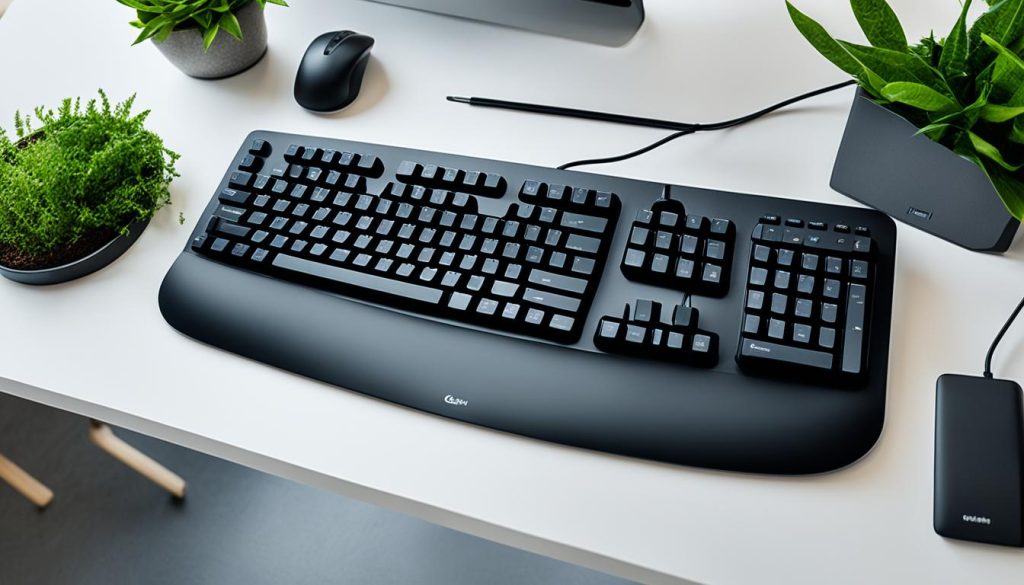Your workspace is key as a blogger. Making it ergonomic can boost your productivity and health. Ergonomic tips for blogging setup help you create a comfy, supportive space. This lets you focus better without physical discomfort. Whether at home or in an office, these tips can change your blogging for the better.
What if your setup could also help with life-work balance and mental health? For my wife, blogging from home has changed everything. A cozy, ergonomic office has boosted her productivity and well-being. It cut down on stress and physical strain from a traditional job1. This made me start blogging too, to share how it’s helped us.
This guide will cover many ergonomic tips for better blogging. We’ll talk about desk height, chair choice, and how to use your keyboard and mouse right. By the end, you’ll know how to make your workspace perfect for you. You’ll be ready to boost your productivity and well-being with your new setup.
The Importance of an Ergonomic Blogging Setup
Creating an ergonomic blogging setup is key for staying productive and feeling good. It helps avoid back pain, neck strain, and wrist problems from sitting too long and doing the same tasks over and over2. A good setup also keeps you in the right posture, which is good for healthy blogging habits that last2.
Improved Productivity and Reduced Discomfort
Working in an ergonomic environment keeps your body in its natural shape, easing muscle, joint, and ligament strain2. This leads to more energy and better health, as good posture helps with breathing and blood flow2. An ergonomic home office setup can stop problems like carpal tunnel syndrome and tendonitis, which hurt your blogging work2.
Setting the Foundation for Healthy Blogging Habits
An ergonomic chair is a top choice for a home office to support your back and keep your spine right2. Using a standing desk converter is also smart to give you a higher work area for standing, which breaks up sitting time2. Starting with these healthy blogging habits makes writing sustainable and productive.
Buying ergonomic furniture and tools, like the portable office toolbox Gustav, makes your workspace better for blogging productivity and health2.
Choosing the Right Ergonomic Chair
The chair you pick for blogging is key to your comfort and posture. It’s vital to get an ergonomic chair that supports your back, especially the lumbar area. This helps keep your spine in its natural “S” curve3.
Choose an ergonomic chair with adjustable parts like seat height, backrest, and lumbar support. This ensures it fits your body perfectly. Ergonomic office chairs usually have a seat height between 16 to 21 inches and are about 17 to 20 inches wide3.
Proper Back Support and Lumbar Cushioning
Lumbar support is crucial for ergonomic office chairs3. A good chair should have an adjustable backrest that supports your lumbar area. This reduces back strain and helps keep you aligned3. It’s also wise to move from your desk every 20-30 minutes to keep your back healthy3.
For long hours at the desk, the best chairs offer adjustable height, lumbar support, and the right seat depth and width. An ergonomic chair with these features can prevent back pain and keep you comfortable during long blogging sessions4.
| Feature | Recommended Specification |
|---|---|
| Seat Height | 16 to 21 inches |
| Seat Width | 17 to 20 inches |
| Lumbar Support | Adjustable and Supportive |
| Backrest Design | Contoured and Adjustable |
Adjusting Your Desk Height
The height of your desk is key to a comfy and productive blogging setup5. Most desks are 28 inches tall, but your ideal height depends on your height and how you type5.
For sitting, desks start at 22.5 inches for those 5’0″ tall and go up with height5. Standing desks range from 36.5 inches for 5’0″ to 47.5 inches for 6’5″5. Adjustable desks can hit up to 52 inches, beating the usual 49 inches5.
Finding the Optimal Desk Height for Typing
For typing, your arms should be flat or slightly down, with wrists straight5. This keeps your typing posture comfy and avoids shoulder and neck pain5. A desk that’s too high or too low can cause wrist or upper body issues5. Use a keyboard tray or adjust your desk to find the best spot for you.
6 A post on desk ergonomics got 67 points and 74 comments6. People shared tips and tools like split keyboards and vertical mice6.
Adjusting your desk height boosts your productivity, comfort, and health as a blogger5. A tailored workspace helps you focus on your creative work better.
Ergonomic Keyboards: Split or Tenkeyless
Choosing the right keyboard for your ergonomic blogging setup is key to comfort and productivity. Ergonomic keyboards, especially split or tenkeyless ones, can ease wrist and hand strain. They also help improve your typing posture and experience.
Split keyboards, like the Matias Ergo Pro7, let you place your hands shoulder-width apart. This reduces strain on your shoulders and wrists. They come with a 9-degree tilt and negative tilt options, keeping your wrists and hands in a neutral position while typing7.
Tenkeyless (TKL) keyboards remove the numeric keypad. This keeps your mouse closer and cuts down on arm movements. It helps keep your posture right and lowers the chance of repetitive strain injuries7.
When picking an ergonomic keyboard, look for programmable keys, adjustable split angles, and wrist support. These features can make typing better and increase your productivity7.
Switching to an ergonomic keyboard might take some getting used to. But, the long-term benefits of less strain and more comfort are worth it. It’s a smart move for a healthier and more productive blogging setup7.
When looking at ergonomic keyboards, the Matias Ergo Pro7 and similar models are great options. Adding these features to your blogging setup can make your workspace better and support your health7.

Selecting an Ergonomic Mouse
Choosing the right mouse can greatly reduce wrist and finger strain. An ergonomic mouse should fit your hand well, keeping your wrist straight8. Consider using trackballs or graphics tablets with a stylus to ease wrist and finger strain even more9.
Reducing Wrist and Finger Strain
Ergonomic mice help lessen wrist and finger strain9. They promote a natural hand position, cutting down on repetitive movements that can cause pain and injuries9. Look for features like vertical orientation, customizable buttons, and a good grip to find your ideal mouse.
Choosing the right mouse is key, but so is how you set it up9. Place your mouse and keyboard close to your body, about 5 cm from the desk edge, to avoid stretching and support your wrists9. Keeping them at elbow height also relaxes your shoulders and prevents harmful movements9.
Your comfort and long-term health should guide your choice of Ergonomic Mouse. By picking the right tools and practicing healthy habits, you can lessen Wrist Strain and Finger Strain. This leads to a more productive and pain-free blogging life89.
Monitor Positioning for Optimal Viewing
Proper monitor positioning is key to reducing eye strain and neck discomfort. Place your monitor so the top of the screen is at or below eye level. Keep it about an arm’s length away10. This setup helps keep your neck in a neutral position and eases eye strain from looking up or down11.
Eye-Level Alignment and Arm’s Length Distance
For the best view, set the monitor so the top of the screen is at or below eye level11. Keep it at least 20 inches (51 cm) away, or an arm’s length, to cut down on eye strain11. A tilt of 10° to 20° back helps keep the right distance between your eyes and the screen11.
If you wear bifocals, try lowering the monitor and tilting it 30° to 45°11. Also, keep your keyboard level with your elbows and tilt it back 10° for wrist comfort11.
| Ergonomic Recommendation | Benefit |
|---|---|
| Monitor at eye level or slightly below | Reduces neck strain by 70-85%10 |
| Monitor positioned an arm’s length away | Decreases eye strain by up to 80%10 |
| Tilting monitor 10-20 degrees back | Maintains optimal viewing distance11 |
| Keyboard at elbow height, tilted 10 degrees | Promotes neutral wrist positioning11 |
By using these ergonomic tips for your monitor, you can make a comfy and productive workspace. This setup cuts down on eye strain and neck strain101112.

Ergonomic Tips for Blogging Setup
Setting up an ergonomic blogging space is key for staying comfortable, productive, and healthy. By making your chair, desk, keyboard, mouse, and monitor ergonomic, you create a space that supports your body. This makes blogging more enjoyable13.
First, focus on back support and lumbar cushioning. A chair that adjusts and supports your back can greatly reduce pain and help you sit better13. Also, having your desk at the right height helps avoid wrist and shoulder pain13.
For your input devices, choose an ergonomic keyboard and mouse to prevent injuries from repetitive tasks. Look for keyboards that split or don’t have a tenkey area to keep your hands in a natural position. Pick a mouse that fits your hand well13. Keeping your monitor at eye level and a distance away also reduces eye and neck pain13.
Don’t forget to take breaks and stretch to keep your posture and alignment right1314. Short breaks help ease muscle tension and boost blood flow14. Adding a standing desk or other ergonomic tools can also make your setup better13.
Using a full ergonomic approach in your blogging setup boosts your productivity and protects your health1315. By making your workspace comfortable and supportive, you’re setting up for a successful and fun blogging path15.
Proper Lighting for Reduced Eye Strain
Good lighting is key for your blogging setup to cut down on eye strain and discomfort. Mixing natural and task lighting helps create a balanced, comfy work area. This setup boosts productivity and keeps you feeling good16.
Combining Natural and Task Lighting
Use natural light from windows as much as you can. It lifts energy, focus, and mood16. Add desk lamps for extra light to avoid eye strain16. Adjustable lights let you set the brightness and color to what you like16.
- Being in natural light can make you 12% more productive and cut down on missing work by 3.5%16.
- Good task lighting can make reading 15% more accurate and cut eye strain by 30%16.
- Adjustable lights can increase productivity by 15-20%16.
Balance natural and task lighting for a comfy, eye-safe blogging space. This setup helps you focus better, feel less tired, and stay healthy16. Don’t forget to check out the importance of good home office and balancing blogging with full-time work for the best results16.
Adjusting your lighting can boost how well you see by 20% for older workers16. The right lighting for computer work cuts eye strain by 50% and makes work more accurate by 10%16.
| Lighting Metric | Recommended Value |
|---|---|
| Color Temperature | 5000-6500 Kelvin17 |
| Eye-Monitor Distance | 20-24 inches17 |
| 20-20-20 Rule | Take a 20-second break every 20 minutes17 |
Use these lighting tips to cut down eye strain, boost productivity, and keep your work area healthy16. Don’t forget to take breaks, stay hydrated, and consider blue light-blocking glasses for your eye health171618.
Standing Desks: A Healthy Alternative
For those looking to add more movement to their blogging, a standing desk is a great choice. These desks let you switch between sitting and standing all day. This helps improve blood flow, boosts energy, and lessens back and neck pain19.
Standing desks are a big help for those who spend hours at their computers. Studies show a big jump in remote work in the U.S., from 2005 to 2017. Now, 67% of employers let or make employees work from home if they didn’t before19. With more people working from home during the COVID-19 pandemic, making your workspace ergonomic is key19.
- Standing burns about 88 calories per hour, more than sitting at 8020.
- The Cora standing desk adaptor is 80cm x 56cm, adjustable from 3.4cm to 39.4cm high20.
- The Urbo rival is smaller at 60cm x 41cm and sits higher on the desk at 7.5cm20.
- Start with 30 to 60 minutes of standing a day and slowly increase sitting time20.
Using a standing desk can improve your posture, boost blood flow, and lower the risk of health problems from sitting too much19. Occupational therapists can get certified to help workers create healthier workspaces19. The CDC has also made statements supporting telehealth, making it easier for people to get the care they need19.
More people are making their workspaces mobile and ergonomic these days19. But, it’s important to watch out for the dangers of working from home, like physical, mental, and environmental issues19. With a standing desk and good ergonomic tips, you can make your blogging setup more comfy and productive19.
Wrist and Forearm Support
When you blog or work on a computer for a long time, it’s key to support your wrists and forearms the right way. Issues like Carpal Tunnel Syndrome and tendinitis can happen if you don’t keep your wrists and forearms in the right position2122. Using things like wrist rests and forearm supports helps keep your wrists and forearms in a neutral position and can ease discomfort.
It’s good to keep your elbows bent at a 90-110 degree angle while typing to avoid wrist strain21. Also, rotating your wrists properly can make typing more comfortable21.
Preventing Repetitive Strain Injuries
The wrist has a narrow tunnel that holds 9 tendons and the median nerve23. If these tendons swell or degenerate, they can press on the median nerve, causing Carpal Tunnel Syndrome23. Using your hands in the same position over and over can lead to this problem, so supporting your wrists and forearms is key23.
Wrist supports were made to cushion and prevent wrist joint pressure on hard surfaces23. But, using them wrong can cause more harm, like making Carpal Tunnel Syndrome worse23. To use a wrist support right, keep a gap between your wrist and the desk, either by supporting your palm or placing it on your forearm23. It’s best to use a wrist support only when needed to avoid putting too much pressure on your palms or forearms23.
Using wrist and forearm supports correctly can make typing more comfortable, help you take breaks, and lower the risk of Repetitive Strain Injuries23.

It’s also important to set up your display to avoid neck strain by keeping it at a distance that stops you from craning your neck21. Adding an external monitor can make your work area better and more ergonomic, costing between $124 and $54021.
| Ergonomic Accessory | Price Range |
|---|---|
| Ergonomic Keyboard (e.g., Microsoft Sculpt) | $66 – $80 |
| Ergonomic Mouse (e.g., Logitech) | $40 – $99 |
| Adjustable Office Chair (e.g., IKEA Markus) | $99 – $229 |
| Adjustable Standing Desk (e.g., IKEA) | $99 – $599 |
By using these ergonomic tools and taking breaks to stretch your hands, wrists, and forearms, you can stop Repetitive Strain Injuries. This keeps your blogging setup comfortable and productive22.
Incorporating Regular Breaks
As a dedicated blogger, it’s easy to get lost in your work. But, taking regular breaks is key for staying productive, health, and feeling good24.
Studies show that short breaks can really boost your productivity. The Pomodoro method, for example, suggests working for 25 minutes and then taking a 5-minute break. This cycle helps improve focus and creativity24. Also, a study in The New Yorker found that walking helped students come up with more ideas than sitting did24.
Regular breaks are good for more than just productivity. They’re also good for your health. Harvard suggests taking breaks every 30 minutes, and shorter breaks are better than longer ones24. Moving around, like standing or walking, can fight the bad effects of sitting too much. It also lowers the risk of musculoskeletal problems25.
To use your breaks well, try tools like the Pomodoro technique or break reminder software. Or, set a timer to remind you to move every hour. The important thing is to find a routine that fits your blogging style24.
By making breaks a part of your daily life, you’ll stay productive, get healthier, and blog better. So, don’t hesitate to take those breaks – your mind and body will be grateful2526.
| Benefit | Impact |
|---|---|
| Improved Productivity | Up to 10% increase in productivity by taking short, frequent breaks25 |
| Reduced Discomfort | Musculoskeletal complaints tend to be lower in sit-stand workstations compared to regular workstations25 |
| Enhanced Well-being | Encouraging a culture of movement, such as active meetings and walking breaks, can lead to increased engagement and focus26 |
Maintaining Good Posture and Alignment
Proper posture and body alignment are key for comfort and less strain while blogging. Don’t hunch over your desk, as it can cause neck tension and shoulder tension27. Instead, sit straight, keep your shoulders back, and keep your spine neutral to support your body all day27.
Poor posture shows as rounded shoulders, a forward head, a hunched back, an arched lower back, and uneven weight distribution, leading to discomfort, muscle tension, and health issues27. A forward head tilt strains the neck and upper back muscles, causing chronic discomfort and neck pain27. Slouched shoulders lead to muscle imbalances, pain, and discomfort in the upper body27. A hunched upper back causes discomfort and stiffness from poor ergonomics, muscle imbalances, or structural issues27. Uneven hip alignment causes body imbalances, leading to discomfort, muscle strain, and pain in the hip, lower back, and legs27.
Long-term discomfort in the back, neck, or shoulders often comes from poor posture, causing muscle strain and bad spinal alignment27. Ergonomic workspaces help by providing the right chair support, placing screens at eye level, and positioning the keyboard correctly, reducing musculoskeletal problems27.
Chairs with good lumbar support keep the spine’s natural curve, reducing lower back strain and preventing pain from sitting too long27. Adjustable standing desks let you switch between sitting and standing, reducing the bad effects of sitting too much on posture27. Doing exercises like shoulder rolls and chest stretches strengthens muscles and helps keep your spine aligned for better posture27. Short walking breaks during work reduce sitting time, lowering the risk of poor posture and muscle strain, keeping your spine healthy and your overall well-being27.
Poor posture can cause or make back pain worse, affecting many who sit in office chairs, work on computers, drive, or stand for long periods28. It’s thought that back pain from poor ergonomics often starts in the neck and spreads to the upper, lower back, and extremities28. Taking breaks every half hour for two minutes can cut down on pains from poor posture28. Ergonomic office chairs with adjustable back support can ease strain on the spine and improve posture for office workers28. Regular exercise, like walking, swimming, or biking, helps prevent injuries from poor posture and keeps good posture in the long run28. Standing for long periods can be helped by wearing supportive shoes and using rubber mats on floors for better comfort and posture28. Making ergonomic workspaces at home and in offices is key for keeping good posture and reducing spine strain28. Overprotecting posture and limiting movement can increase pain and create a cycle of limited motion in those with back pain28.

Avoiding Neck and Shoulder Tension
Keeping proper posture and alignment is key to reducing neck tension and shoulder tension during blogging. Be aware of your body’s position and take regular breaks to prevent discomfort and support long-term spinal health.
Customizing Your Workspace
Making an ergonomic blogging setup is more than just picking the right gear. To boost your productivity and comfort, it’s key to customize your workspace to fit your needs and likes29. Try out different chair, desk, and accessory setups to find the best mix of Workspace Customization, Comfort, and Productivity.
Begin by making sure your chair has good lumbar support and a comfy reclined angle for your spine29. Adjust the seat height and depth so your feet can rest flat or on a footrest, with knees at or below hips29. Add adjustable armrests to keep your shoulders relaxed and elbows even with the floor29.
Next, place your monitor at the right viewing distance and angle to cut down eye and neck strain29. Use a monitor arm to change the screen’s height and tilt for better ergonomics30. Add proper lighting to lessen eye fatigue, using both natural and task lighting30.
With these ergonomic tips in mind, you can make a customized workspace that’s comfy and boosts your productivity29. Follow the 20-20-20 rule and take breaks to stretch, making your blogging work fun and lasting29.
| Ergonomic Workspace Elements | Recommended Settings |
|---|---|
| Chair Recline Angle | 100-110 degrees |
| Lumbar Support | Follow natural curve of lower back |
| Seat to Knee Clearance | 3-4 fingers’ width |
| Feet Position | Flat on floor or footrest, knees level with hips |
| Monitor Distance | 20-40 inches (arm’s length) |
| Monitor Viewing Angle | Top of screen at or below eye level |
| Screen Brightness | Reduce eye strain with f.lux software |
By customizing your workspace with these ergonomic tips, you can make a comfortable and productive space for your blogging2930.
Investing in Ergonomic Accessories
Adding ergonomic accessories to your setup can make you more comfortable and productive. Think about getting a top-notch ergonomic chair that supports your back and has good lumbar cushioning31. Also, consider an adjustable standing desk to help you switch between sitting and standing during the day32.
Don’t forget a split keyboard and an ergonomic mouse to ease wrist and hand strain33. Make sure your monitor is at eye level and within reach to reduce neck and shoulder pain33. Using task lighting and blue-light blocking glasses can also cut down on eye strain and help you sleep better31.
Buying ergonomic accessories is key to a healthier and more efficient workspace. It helps prevent muscle problems, boosts your mood, and can make you more productive32. As technology gets better, we might see even more advanced ergonomic workwear with smart features like health sensors32.
Source Links
- https://www.nytimes.com/wirecutter/blog/7-things-you-need-for-an-ergonomically-correct-workstation/
- https://gustavconcept.com/en-us/blogs/news/ergonomic-working
- https://bodybilt.com/how-to-choose-the-right-ergonomic-office-chair-for-your-needs/
- https://www.theblogsmith.com/blog/ergonomic-office-chair/
- https://www.branchfurniture.com/blogs/turn-key/ergonomic-desk-height-guide
- https://news.ycombinator.com/item?id=21623319
- https://deleteman123.medium.com/is-this-the-best-keyboard-for-a-developer-5a2bcc220aaf
- https://www.ergolink.com.au/blog/7-expert-tips-for-the-perfect-ergonomic-mouse-and-keyboard-setup
- https://www.posturite.co.uk/blog/six-of-the-best-ergonomic-tips-for-keyboard-and-mouse-setup
- https://bluespaceinteriors.com/ergonomic-tips-for-monitor-placement-and-set-up/
- https://www.ergotron.com/en-us/ergonomics/ergonomic-equation
- https://ergo-plus.com/office-ergonomics-position-computer-monitor/
- https://us.anteagroup.com/news-events/blog/how-set-home-office-basic-ergonomic-tips
- https://www.premisehealth.com/resources/blog/how-to-set-up-an-ergonomically-friendly-workstation/
- https://www.kensington.com/news/ergonomic-workspace-blog/how-to-improve-your-ergonomic-desk-setup-with-proper-desk-posture/
- https://www.benq.com/en-us/knowledge-center/knowledge/how-lighting-ergonomics-affects-employee-productivity.html
- https://www.uoosd.com/workplace-eye-health
- https://eurekaergonomic.com/blogs/eureka-ergonomic-blog/how-to-prevent-eye-strain-10-tips-for-eye-health-at-your-desk
- https://www.occupationaltherapy.com/articles/work-from-wherever-ergonomic-tips-5328
- https://nanosphere.co.uk/2020/09/standing-desk-a-better-way-to-work-from-home/
- https://dfeldman.medium.com/ow-my-arm-ergonomic-tips-for-the-wfh-worker-63cb3d8efeb0
- https://www.osswf.com/blog/ergonomic-tips-for-office-workers-preventing-hand-wrist-elbow-strain
- https://www.nomorepainergonomics.com.au/blogs/no-more-pain-ergonomics/how-to-position-a-wrist-support
- https://corporatetraining.usf.edu/blog/6-ergonomic-tips-for-working-from-home
- https://www.ergonomicshelp.com/blog/break-strategy
- https://sit-stand.com/blog/strategies-and-solutions-for-incorporating-movement
- https://www.physiotattva.com/blog/10-tips-to-improve-posture-and-ergonomics-physiotattva
- https://accessphysicaltherapywellness.com/10-tips-for-improving-posture-and-ergonomics/
- https://zapier.com/blog/how-to-set-up-your-desk/
- https://x-team.com/blog/ergonomic-workspace
- https://www.tribeloo.com/blog-post/tips-for-creating-a-productive-home-office-setup
- https://thriveworkwear.com/blogs/resources/enhancing-workplace-efficiency-the-role-of-ergonomic-accessories-in-modern-workwear
- https://www.4xem.com/blogs/blog/the-advantages-of-ergonomic-accessories-for-your-laptop-or-desktop-setup

